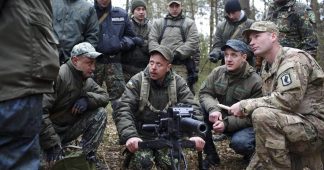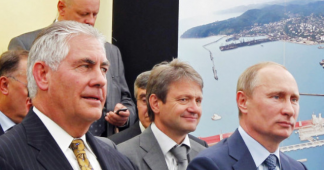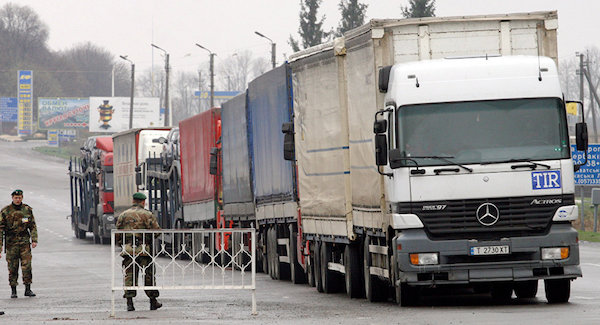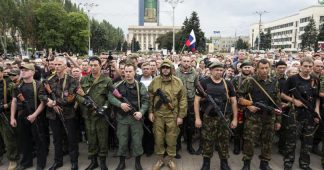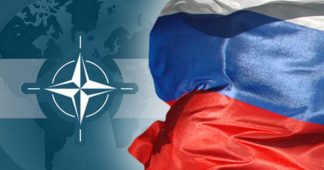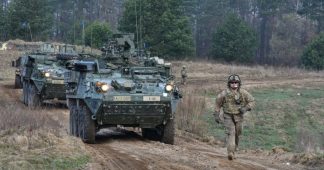Mattis in Kiev: US may arm Ukraine with lethal weapons
By Niles Niemuth
25 August 2017
US Defense Secretary James Mattis declared during a trip to Ukraine on Thursday that the American government is actively considering moving forward with a plan to arm Kiev with lethal weaponry for the first time.
While alleged Russian intervention in the country’s eastern Donbass region and the annexation of Crimea are put forward as the reasons for the American-led military buildup in Ukraine, the conflict was sparked by the 2014 US- and German-backed, fascist-led coup in Kiev. The Obama administration supported the rabidly nationalist and anti-Russian movement that ousted the Russian-aligned president, Viktor Yanukovych, after he refused to sign an association agreement with the European Union.
The Kremlin responded to the coup by annexing Crimea after a popular referendum in the Russian-speaking peninsula registered overwhelming support for joining the Russian Federation. Moscow has also supported pro-Russian separatists in the eastern part of Ukraine. Some 10,000 have already been killed and more than 2 million displaced in more than three years of war triggered by the dispatch of Ukrainian troops to crush the rebellion in the east by the government of billionaire oligarch Petro Poroshenko in Kiev. The escalation being prepared by the Trump administration portends even greater bloodshed.
Under a provocative plan drawn up by officials at the Pentagon and State Department, first reported by the Wall Street Journal at the end of July, the Trump administration would deliver Javelin antitank missiles, antiaircraft weaponry and other lethal arms to the regime in Kiev. The Obama administration held off on such a move, supplying only so-called “nonlethal” arms, in part to assuage Germany, France and other EU countries, which opposed it. The Organization for Security and Cooperation in Europe, at the initiative of Germany and France, negotiated the Minsk peace accord in September of 2014 with Russia, Kiev and the eastern Ukraine rebels in large part to head off US plans to arm the Kiev regime.
Mattis’s trip to Ukraine, the first visit by a US defense secretary in a decade, was timed to coincide with the country’s celebration of its 1991 declaration of independence from the Soviet Union.
After reviewing a military parade in which a US National Guard unit marched alongside Ukrainian soldiers, the Pentagon chief addressed the question of arms shipments, declaring that any weapons the US provided would be used only for “defensive” purposes.
“On the defensive lethal weapons, we are actively reviewing it,” Mattis announced at a joint press conference with Poroshenko, where both adopted a hostile posture towards Russia.
Mattis’s remarks made clear that a decision on the provisioning of weapons would come soon after he returned to Washington. “I will go back now having seen the current situation and be able to inform the secretary of state and the president in very specific terms what I recommend for the direction ahead,” he said.
President Donald Trump has given Mattis and his generals wide leeway in setting military policy. American military planners are already considering locations for training Ukrainian soldiers on how to use the Javelin missiles. According to anonymous administration officials cited by the New York Times, Secretary of State Rex Tillerson, who visited Kiev in July, supports the plan.
“Defensive weapons are not provocative unless you are an aggressor, and clearly Ukraine is not an aggressor since it is their territory where the fighting is happening,” Mattis told reporters.
Poroshenko made clear that the weaponry would be used to attack any Russian forces perceived to be threatening Ukraine. “Any defensive weapons would be just to increase the price if Russia makes a decision to attack my troops and my territory,” he declared.
A proposal to send billions of dollars in lethal weaponry to the Ukrainian government, including antitank missiles, was first floated by officials within the Obama administration in early 2015. President Barack Obama eventually rejected the proposal, which was seen as a highly inflammatory measure that could spark a wider conflict in Eastern Europe and the Baltic states.
The Obama administration focused instead on building up the Ukrainian armed forces by deploying military trainers to the country and providing hundreds of millions of dollars of “nonlethal” aid, including body armor, night vision goggles, first aid kits, Humvees and radar for pinpointing mortar fire. A training outpost staffed by British, Canadian, Lithuanian, Polish and US National Guard soldiers on a rotational basis has been operating in western Ukraine near the border with Poland since 2015.
While Trump had expressed hopes for improved relations with the government of Russian President Vladimir Putin, diplomatic and military relations have continued to sour. Trump signed a new round of sanctions targeting Russia earlier this month after a sanctions bill was overwhelmingly approved by both Democrats and Republicans in Congress by a veto-proof margin.
Eastern Europe, Syria and East Asia are all potential flash points for a catastrophic war between nuclear-armed powers.
In Eastern Europe, Russia is preparing to undertake the Zapad 17 war games in mid-September, which will mobilize thousands of military personnel and support staff in Belarus, mainland Russia and the exclave of Kaliningrad, which borders Poland, Lithuania and the Baltic Sea. During his visit to the Baltics in July, Vice President Mike Pence discussed the possibility of deploying Patriot missile systems to Estonia in response to the Russian exercises, which are reportedly the largest since the Cold War.
In Syria, the US is backing the predominantly Kurdish Syrian Democratic Forces while Russia is backing the government of President Bashar al-Assad. While the two militaries regularly communicate about their operations in Syria, a single mishap could cause the situation to spiral out of control. In June, the US shot down a Syrian fighter jet and two Iranian drones as they approached areas controlled by US-backed forces.
In East Asia, President Trump recently threatened North Korea, with which Russia and China both share borders, with a nuclear attack if it did not give up its nuclear weapons program. Russia responded to joint war games between the US and South Korea this week by flying nuclear-capable bombers accompanied by fighter jets and surveillance aircraft around the Korean peninsula. Japanese and South Korean fighters were scrambled to intercept the Tupolev bombers as they flew through international airspace over the Pacific Ocean, the Sea of Japan, the Yellow Sea and the East China Sea.
